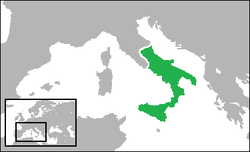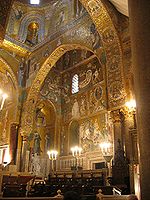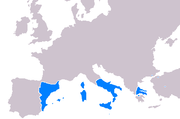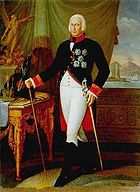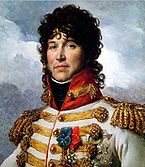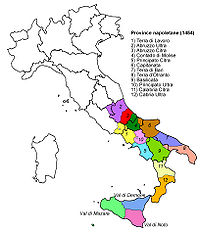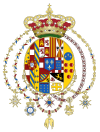- Kingdom of the Two Sicilies
-
For other uses, see Two Sicilies (disambiguation).
Kingdom of the Two Sicilies
Regno delle Due Sicilie (it)
Regno d’’e Doje Sicilie (nap)
Regnu dî Dui Sicili (scn)← 
←
1816–1861  →
→

Flag of the Two Sicilies Coat of arms Anthem
Inno al Re
(Hymn to the King)The Kingdom of the Two Sicilies (green). Capital Naples Language(s) Italian (official),
Sicilian, NeapolitanReligion Roman Catholic Government Absolute monarchy King - 1816-25 Ferdinand I - 1825-30 Francis I - 1830-59 Ferdinand II - 1859–61 Francis II History - Established 12 December 1816 - Italian unification 12 February 1861 Area - 1860 111,900 km2 (43,205 sq mi) Population - 1860 est. 8,703,000 Density 77.8 /km2 (201.4 /sq mi) Currency Two Sicilies ducat The Kingdom of the Two Sicilies, commonly known as the Two Sicilies even before formally coming into being,[1] was the largest and wealthiest of the Italian states before Italian unification.[2] It was formed of a union of the Kingdom of Sicily and the Kingdom of Naples in 1816 and lasted until 1860, when it was annexed by the Kingdom of Sardinia, which became the Kingdom of Italy in 1861. The Two Sicilies had its capital in Naples and was commonly referred to in English as the "Kingdom of Naples". The kingdom extended over the Mezzogiorno (the southern part of mainland Italy) and the island of Sicily.
The name "Two Sicilies" originated from the division of the medieval Kingdom of Sicily. Until 1285, the island of Sicily and the Mezzogiorno were both part of the Kingdom of Sicily. As a result of the War of the Sicilian Vespers[3] the King of Sicily lost Sicily proper to the Aragonese but remained king over the peninsular part of the realm. Although his territory became known as the Kingdom of Naples, he and his successors never gave up the title of "King of Sicily" and they referred to their realm as the "Kingdom of Sicily". At the same time, the Aragonese rulers of the island of Sicily called their realm the "Kingdom of Sicily". Thus, formally, there were two kingdoms calling themselves "Sicily"[3]: hence, the Two Sicilies
Contents
Background
Establishment of the Kingdom of the Two Sicilies
The Kingdom of the Two Sicilies resulted from the unification of the Kingdom of Sicily with the Kingdom of Naples (called the kingdom of peninsular Sicily), by King Alfonso V of Aragon in 1442. The two had been separated since the Sicilian Vespers of 1282. At the death of King Alfonso in 1458, the kingdom became divided between his brother John II of Aragon, who kept Sicily, and his bastard son Ferdinand, who became King of Naples.
In 1501, King Ferdinand II of Aragon, son of John II, conquered Naples and reunified the two kingdoms under the authority of the newly united Spanish throne. The title King of Sicily and of the Two Coasts of the Strait was then borne by the Kings of Spain until the War of the Spanish Succession. At the end of the war, the Treaty of Utrecht in 1713 granted Sicily to the Duke of Savoy, until the Treaty of Rastatt in 1714 left Naples to the Emperor Charles VI. In 1720 the Emperor and Savoy exchanged Sicily for Sardinia, thus reuniting Naples and Sicily.
In 1734, Charles, Duke of Parma, son of Philip V of Spain, took the Sicilian crown from the Austrians and became Charles the VII & V, giving Parma to his younger brother, Philip. In 1754, he became King Carlos III of Spain and resigned Sicily and Naples to his younger son, who became Ferdinand III of Sicily and Ferdinand IV of Naples, and later crowned Ferdinand I of the Two Sicilies. Apart from an interruption under Napoleon, the Kingdom of the Two Sicilies remained under the Bourbon line (Bourbon Duo-Sicilie) continually until 1860.
In January 1799, Napoleon Bonaparte, in the name of the French Republic, captured Naples and proclaimed the Parthenopaean Republic, a French client state, as successor to the kingdom. King Ferdinand fled from Naples to Sicily until June of that year. In 1806, Bonaparte, by then French Emperor, again dethroned King Ferdinand and appointed his brother, Joseph Bonaparte, as King of Naples. In the Edict of Bayonne of 1808, Napoleon removed Joseph to Spain and appointed his brother-in-law, Joachim Murat, as King of the Two Sicilies, though this meant control only of the mainland portion of the kingdom.[4][5] Throughout this Napoleonic interruption, King Ferdinand remained in Sicily, with Palermo as his capital.
King Ferdinand I was restored by the Congress of Vienna of 1815. He established a concordat with the Papal States, which previously had a claim to the land.[6]
There were several rebellions on the island of Sicily against the King Ferdinand II but the end of the kingdom was only brought about by the Expedition of the Thousand in 1860, led by Garibaldi, an icon of the Italian unification, with the support of the House of Savoy and their Kingdom of Piedmont-Sardinia. The expedition resulted in a striking series of defeats for the Sicilian armies against the growing troops of Garibaldi. After the capture of Palermo and Sicily, he disembarked in Calabria and moved towards Naples, while in the meantime the Piedmontese also invaded the Kingdom from the Marche. The last battles fought were that of the Volturnus in 1860 and the siege of Gaeta, where King Francis II had sought shelter, hoping for French help, which never came. The last towns to resist Garibaldi's expedition were Messina (which capitulated on 13 March 1861) and Civitella del Tronto (which capitulated on 20 March 1861). The Kingdom of the Two Sicilies was dissolved and annexed to the new Kingdom of Italy, founded in the same year.
The fall of the Sicilian aristocracy in the face of Garibaldi’s invasion is recounted in the novel The Leopard by Giuseppe Tomasi di Lampedusa and its film adaptation.
Origins of the two kingdoms
Main articles: Kingdom of Sicily and Kingdom of NaplesThe monarchy over the areas which would later become known as the Two Sicilies, existing as one single kingdom including peninsula and insular, in fact goes back to the time of the Middle Ages. The Norman king Roger II formed the Kingdom of Sicily by combining the County of Sicily with the southern part of the Italian Peninsula (then known as the Duchy of Apulia and Calabria) as well as the Maltese Islands. The capital of this kingdom was Palermo — on the actual island of Sicily. The state existed in that form from 1130 until 1285. In the reign of the Capetian House of Anjou king Charles I, the kingdom was split by the War of the Sicilian Vespers.[3] Charles, who was of French origin, lost Sicily proper to the House of Barcelona, who were Aragonese and Catalan, with support from the natives.[3] Charles remained king over the peninsular part of the realm, thereafter informally known as the Kingdom of Naples. Officially he never gave up the "Kingdom of Sicily" name and thus there were two kingdoms calling themselves "Sicily".[3]
Aragonese and Spanish direct rule
Main articles: Crown of Aragon and Spanish EmpireIt wasn't until the Peace of Caltabellotta in 1302, sponsored by Pope Boniface VIII, that the two kings of "Sicily" recognized each other's legitimacy; the island kingdom then became the "Kingdom of Trinacria" in an official context, though the populace still called it Sicily.[3] Eventually by 1442 the Angevin line of Kings of Naples was coming to an end. Alfonso V of Aragon who was the King of Sicily in terms of the island itself via direct rule from the Crown of Aragon, conquered Naples and became king of both.
Alfonso V described the geographical area in Latin as Utriusque Siciliæ, which is along the lines of "Both Sicilies", this is the title he used.[7] After the death of Alfonso, both remained under direct rule from the Crown of Aragon, but Naples had a different Aragonese king from the island of Sicily from 1458 until 1501. For a brief period Naples was controlled by a different power than Sicily, in the form of French king Louis XII of France who took the mainland kingdom and held it for around three years. After the Battle of Garigliano led by last Aragonese king Ferdinand II of Aragon however, the two areas were once again under control of the same power and exactly the same king.
From 1516 when Charles V, Holy Roman Emperor became the first King of Spain, both Naples and Sicily were under direct Spanish rule. It was during this era that Charles V granted the islands of Malta and Gozo, which had been part of the Kingdom of Sicily for four centuries, to the Knights Hospitaller (thereafter known as the Order of Malta). The period of direct Spanish rule under the same line of kings lasted until 1713, when Spain and both Sicilies passed to Philip, duke of Anjou, who founded the Spanish branch of the House of Bourbon. Briefly interrupted by an eight year spell of Savoy rule of Sicily, the two kingdoms fell under the same king after the Treaty of The Hague, as Austrian king Charles VI, Holy Roman Emperor was named ruler.
History
Uniting of the Crowns
The kingdoms were conquered from the Austrians by a young Spanish prince during the War of the Polish Succession who would then become Charles VII of Naples. The two kingdoms were then recognised as both independent and under Charles' rule as a cadet branch of the Spanish Bourbons by the Treaty of Vienna.[8] After Charles' brother, Fernando VI of Spain died childless, Charles inherited the Spanish Crown in 1759, reigning as Charles III of Spain. His son Ferdinand then became king of the two kingdoms so as to maintain them as separate realms (as required by the treaties restoring junior Spanish dynasts to the southern Italian kingdoms). Ferdinand was highly popular with the lazzaroni class. Ferdinand's reign was highly eventful. For a brief period the Parthenopaean Republic was instated in Naples by French Revolution supporters; however, a counter-revolutionary army of lazzaroni retook Naples in order to restore royal power.[9]
However only eight years later, Napoleon conquered the peninsula part of the kingdom during the War of the Third Coalition and instated his brother Joseph Bonaparte as king.[10] Ferdinand fled to his other kingdom, on the island of Sicily itself; here the alliance he had previously made with George III of the United Kingdom and Tory Prime Minister the Earl of Liverpool saved him. The British protected Ferdinand and the island of Sicily from Napoleonic conquest with the presence of a powerful Royal Navy fleet.[11]
Meanwhile, back on the mainland Joachim Murat had become the second Bonapartist king. In the Edict of Bayonne he was named as "King of the Two Sicilies",[4] though de facto he never actually held the island of Sicily where Ferdinand was, and is usually referred to as just a King of Naples.[12] Murat actually switched sides for a while, abandoning the Grand Army after the disastrous Battle of Leipzig in an attempt to save his Neapolitan throne. However, as the Congress of Vienna progressed, tensions arose as there was strong pressure to restore Ferdinand to the Neapolitan kingdom as well as keeping his Sicilian one.[10] Murat returned to Napoleon and together they declared war on the Austrian Empire, leading to the Neapolitan War in March 1815. Ferdinand and his allies Austria, Britain and Tuscany were victorious, restoring him to his Neapolitan throne. To avoid further French attempts, it was agreed at the Congress of Vienna that Ferdinand would reunite his kingdom.
Invasion by Sardinia
Between 1816 and 1848, the island of Sicily experienced three popular revolts against Bourbon rule, including the revolution of independence of 1848, when the island was fully independent of Bourbon control for 16 months.
Apart from having occurred at the same time as the Revolutions of 1848, there is a clear link between this revolution and the Risorgimento eleven years later.
Geography
Departments
The peninsula was divided into fifteen departments[13] and the island of Sicily was divided into seven departments.[14] The island itself had a special administrative status[citation needed], with its base at Palermo.
In 1860, when the Two Sicilies were conquered by the Kingdom of Sardinia, the departments became provinces of Italy, according to the Rattazzi law.
Peninsula Capital 1  Abruzzo Ultra I
Abruzzo Ultra ITeramo 2  Abruzzo Ultra II
Abruzzo Ultra IIAquila 3  Abruzzo Citra
Abruzzo CitraChieti 4  Contado del Molise
Contado del MoliseCampobasso 5  Terra di Lavoro
Terra di LavoroCapua,
from 1818 Caserta6  Naples
NaplesNaples 7  Principato Ultra
Principato UltraAvellino(*) 8  Principato Citra
Principato CitraSalerno 9  Capitanata
Capitanataoriginally San Severo, then Foggia 10  Terra di Bari
Terra di BariBari 11  Terra d'Otranto
Terra d'OtrantoLecce 12  Basilicata
BasilicataPotenza 13  Calabria Citra
Calabria CitraCosenza 14  Calabria Ultra II
Calabria Ultra IICatanzaro 15  Calabria Ultra I
Calabria Ultra IReggio
Insular Capital 16  Caltanissetta
CaltanissettaCaltanissetta 17  Catania
CataniaCatania 18  Girgenti
GirgentiGirgenti 19  Messina
MessinaMessina 20  Noto
NotoNoto 21  Palermo
PalermoPalermo 22  Trapani
TrapaniTrapani * The city of Benevento was formally included in this department, but it was occupied by the Papal States and was de facto an exclave of that country.
Economy
Assets
According to the studies of Francesco Saverio Nitti, the kingdom had 443.3 million golden lire (about 65.7% of all the money circulating in the peninsula), and it was the richest among the other Italian states.
Assets distribution in the Italian peninsula before unification[15]
State Assets (in millions of golden lires) Percentage of circulating money Kingdom of the Two Sicilies 443,3 65,7% Papal State 90,7 14% Tuscany 85,3 12,9% Kingdom of Sardinia 27,1 4% Venice 12,8 1,9% Lombardia 8,1 1,2% Parma and Modena 1,7 0,3% Industry
The industry, as in many other states at the time, was much less important than agriculture, but it was very well developed and advanced at the time and it was indeed, supported by the government. One of the most important industrial complexes in the kingdom was the Shipyard of Castellammare di Stabia, which employed 1800 workers. Another important complex was the engineering factory of Pietrarsa, the largest industrial plant in the Italian peninsula which produced tools, cannons, rails, locomotives. The complex also included a school for train drivers, and naval engineers and thanks to this school, the kingdom was able to replace the English personnel which was necessary until then. The first steamboat with screw propulsion known in the Mediterranean Sea is the Giglio delle Onde, with mail delivery and passenger transport purposes since 1847.
There was the Fonderia Ferdinandea in Calabria, which was a large foundry where cast iron was produced in huge amounts and the Polo siderurgico di Mongiana (an iron processing complex and weapons factory). The latter employed 2700-2800 workers. In Sicily (near Catania and Agrigento), there was a very well developed mining industry, focused on the extraction of sulphur which was a fundamental element in the production of gunpowder. The sicilian mines were able to satisfy most of the sulphur world demand. The cloth production was focused in San Leucio (near Caserta), particularly silk. The region of Basilicata also had several of such facilities, like the ones in Potenza and San Chirico Raparo, where cotton, wool and silk were processed.
The food industry was scattered all over the territory, and it was particularly focused near the area of Naples (Torre Annunziata and Gragnano), with many exportations of pasta which involved many European states and the United States of America.
Transports
In the late 18th century, the road conditions in the kingdom were poor, especially in the country and hinterland areas. This situation made transporting goods and trading inside the kingdom, quite difficult. In the last 30 years of its history, many improvements were made but no attempt was efficient enough to radically improve the overall road conditions.
Technological and Scientific achievements
The kingdom achieved several scientific and technological accomplishments, such as the first steamboat in the Mediterrean Sea (1818), built in the shipyard of Stanislao Filosa al ponte di Vigliena, near Naples, and the first railway in the Italian peninsula (1839), which connected Naples to Portici. However, until the Italian unification, the railway development was highly limited. In the year 1859, the kingdom had only 99 kilometers of rails, compared to the 800 kilometers of Piedmont. This was because the kingdom could count on a very large and efficient merchant navy, which was able to compensate and replace the need for railways. Also , southern landscape was mainly mountainous making the process of building railways quite difficult, as building railway tunnels was much harder at the time. However, the first railway tunnel in the world was built there. Among the other achievements, one worth mentioning is the first suspension bridge in Continental Europe (1832), the first gaslight in Italy (1839), the first volcano observatory in the world, l'Osservatorio Vesuviano (1841), the first and actual archaeological excavations in the world( in the ancient cities of Pompei and Ercolano), the first faculty of Economics in Europe and the first faculty of Astronomy in Italy . The first suspension bridge, built in iron, the "Real Ferdinando" on the river Garigliano and it was built in the Reali Ferriere factory and Weapons factory in Mongiana. The rails for the first Italian railways were built in Mongiana as well. All the rails of the old railways that went from the south to as far as Bologna were built in Mongiana.
Naples was the most populated city in Italy, and third in Europe and, according to many official sources, it was the 7th or 4th most populated city in the world prior to the 19th century. Naples was also the city with the highest amount of typographies in Italy and also had the highest number of theaters and music schools.
Monarchy
Kings of the Two Sicilies
Main articles: Monarchs of the Two Sicilies, Monarchs of Sicily, and Monarchs of Naples
Ferdinand I
1816–1825

Francis I
1825–1830

Ferdinand II
1830–1859

Francis II
1859–1861
In 1860–61 the kingdom was conquered by the Kingdom of Sardinia, and the title dropped. It is still claimed by the head of the House of Bourbon-Two Sicilies.
Titles of King of the Two Sicilies
Francis I, King of the Two Sicilies, of Jerusalem, etc., Duke of Parma, Piacenza, Castro, etc., Hereditary Grand Prince of Tuscany, etc.
The House of Bourbon in exile
Some Sovereigns continued to maintain diplomatic relations with the exiled Court, including the Emperor of Austria, the Kings of Bavaria, Württemberg and Hanover, the Queen of Spain, the Emperor of Russia, and the Papacy.
Heads of the Royal House of the Two Sicilies, 1861–present
Two Sicilies Royal Family

